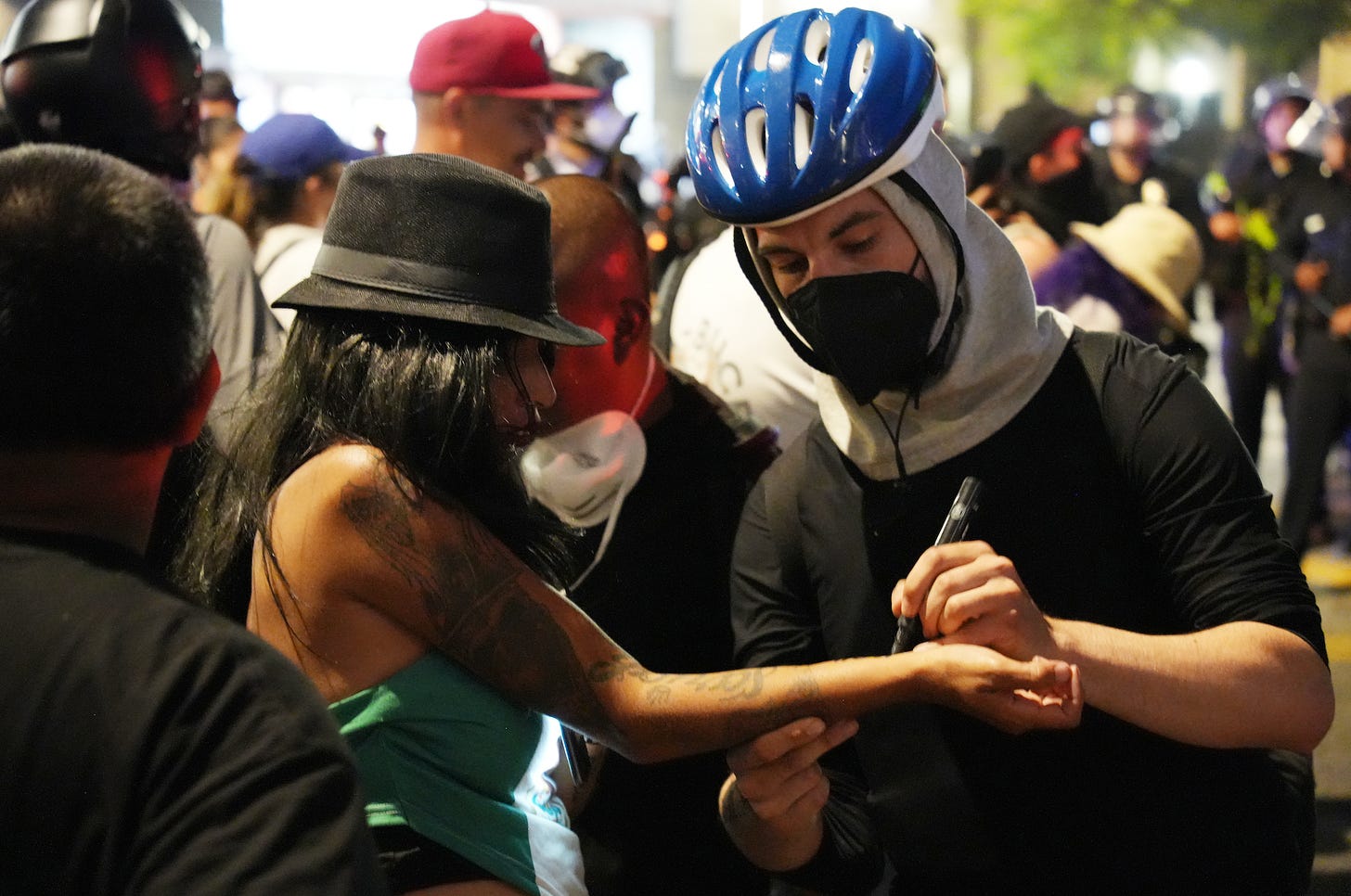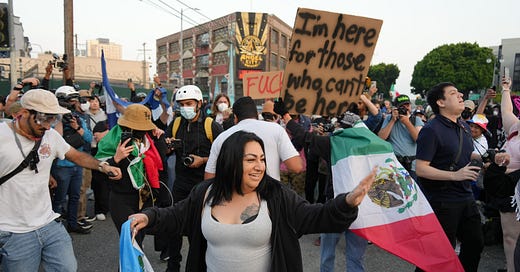When the LA Community Speaks — and the Government Sends Troops
Plus: a legal expert on military overreach, a photographer capturing joy, and a journalist reporting violations against the press.
Welcome back to another edition of The Detour. Every other week I explore the context and consequences behind U.S. and global affairs.
Today, we’re bringing one flashpoint in sharper focus: Over the weekend, protests erupted across Los Angeles in response to ICE raids. Since then, demonstrations have spread to at least 12 major U.S. cities. LA briefly imposed — and then lifted — an 8 p.m. curfew, while President Trump deployed 2,000 National Guard troops, with 2,000 more en route, along with 700 active-duty Marines to “temporarily protect ICE and other U.S. Government personnel.” California Gov. Gavin Newsom condemned the move, accusing the administration of “pushing mass deportations indiscriminately” and targeting immigrant families “regardless of their roots.”
Let’s dive in. Here’s what’s on deck:
🚓 A press rights advocate tracking LAPD violations against journalists
📷 A photojournalist capturing joy, community, and resistance across LA
⚖️ A former National Guard officer and a martial law expert weigh in on the military presence in LA
The Detour is published in partnership with Frame Media, a creative software tool that evolved out of a multimedia journalism publication. Frame allows anyone to create visual, engaging stories that can be hosted online or published to social media. If you’re interested in trying Frame, join the waitlist here.
30 — The minimum number of alleged violations committed by LAPD officers against members of the press since protests began on Friday, according to Adam Rose, who is a press rights officer for the LA Press Club. Rose has been tracking these incidents in a public spreadsheet and told me that at least five journalists were hospitalized due to injuries inflicted by local law enforcement.
The documented violations range from journalists being shoved and subjected to searches of their property without consent, to being shot with less-lethal weapons (LLMs) like rubber bullets.
“To me, it is ironclad proof that the LAPD is acting unlawfully and cannot police its own officers. And that's something the public needs to see, the public needs to understand, and that civic officials need to respond to,” Rose told me.
Rose would know. He played a key role in writing California Penal Code 409.7 (originally Senate Bill 98) “down to the placement of commas.” The law protects journalists covering unlawful assemblies from arrest or interference by law enforcement. Despite this safeguard, “the issue is what happens in the field,” said Rose. “The complete and total disrespect for the law that law enforcement has demonstrated over the last few days should terrify everyone. It means there is no law. What are they enforcing? It's whatever they want.”
Scroll down for a deeper look into the solutions Rose hopes will emerge to protect the press and the peaceful demonstrators they cover.
$134 million — The total expected cost of the military response in LA, according to the Pentagon's acting comptroller in a hearing Tuesday. While legal experts say the move, under Title 10 of the federal code, is technically legal, the question of overreach remains razor-thin. On Wednesday, Maj. Gen. Scott Sherman told the Associated Press that National Guard troops will assist ICE agents with immigration operations and confirmed that troops are now authorized to temporarily detain people until police can make arrests.
"It feels like it's just putting our National Guard soldiers at unnecessary risk, especially with the authorities that they're operating under," Dylan Blaha, a National Guard veteran of 12 years, told me. "I don't even think it's clear to me what they're supposed to be doing."
Blaha explained that the deployment process has been unprecedented. "Normally you're supposed to receive at least 30 days notice before any type of deployment. ... These National Guard soldiers are civilians most of the time throughout the year, and they'll definitely be impacted by this,” he said.
The lack of gubernatorial consent adds another layer of concern. "The fact that Governor Newsom has made it very clear that he doesn't want those troops activated — it's very concerning," Blaha continued. "1965 was the last time that a president activated National Guard troops without the governor's approval."
Democracy expert Rosarie Tucci emphasized the broader implications of the presidential memorandum, which she explained “has a forward-looking component to it, and no geographical limitation.”
"This isn't about deportation. This is about laying out a power grab," she said.
6 — The minimum number of indicators legal experts say to watch for ahead of any institution of martial law. Tucci and other constitutional scholars are closely monitoring logical warning signs that could signal an escalation of federal power in the United States.
The potential indicators they're tracking include no-knock raids, expanded surveillance programs, deployment of federal agents in civilian areas, mass arrests coupled with curfews, militarization of local police forces, and suppression of dissent. These elements, when combined, create the foundation for martial law implementation.
"People do have the power. We can say no to a power grab," Tucci emphasized. "The story's not finished."
18 — The number of years the city of Glendale, just north of LA, has maintained facilities to house federal immigration detainees for ICE agents. That contract came to a dramatic end Sunday.
How can journalists feel safe to do their job, and demonstrators feel safe to peacefully protest, in this moment?
"Now, we need accountability. Now we need, maybe, laws with more teeth," Adam Rose of the LA Press Club told me. California's current legal protections for journalists, while groundbreaking, are proving insufficient against systematic police violations. Rose argues the state needs "laws that say officers will be held criminally accountable and lose their qualified immunity for civil cases" if they violate press and peaceful demonstration protections.
Beyond legal reforms, experts point to organized resistance models. Democracy expert Tucci referenced South Korea's December 2024 resistance against martial law, where labor unions like the Korean Confederation of Trade Unions immediately condemned overreach and organized general strikes.
This success wasn't spontaneous, Tucci told me. It was built on decades of coalition-building: Organizers had thousands of trained activists prepared over years, with ongoing protests creating momentum before the critical moment arrived.
“In our studies of backsliding around the world, without a civil resistance movement, the success rate in in creating a Democratic U turn is around 7.5 percent. With a civil resistance movement, [the likelihood of a successful Democratic U turn] increases to 52 percent.”
"I am a child of immigrants — one parent was deported when I was 10, and that had a lasting impact. By the time he came back, I was already a mom and he was a grandpa. You can never get that time back.”
— Monica De Leon, an LA local, to journalist Allison Lau in Marie Claire.
Over the weekend, journalist Allison Lau — whom I’ve featured in The Detour before — photographed the women at the frontlines for Marie Claire. One of them was Monica De Leon, whose story deeply shaped Lau’s understanding of the stakes many immigrant communities are in right now.
What she witnessed on the ground was a powerful duality: on one hand, there were scenes of joy, solidarity, and cultural pride; on the other, a militarized response marked by fear and intimidation.
In hubs like the Arts District and Little Tokyo, which is home to many immigrant and undocumented families, protests reportedly began peacefully. Participants waved flags of solidarity from the U.S., Mexico, and Palestine; there was music, dancing, and calls for justice led by people across generations advocating for their communities. “Joy is a very big part of resistance,” Lau said.
But after dark, Lau told me that there was a noticeable shift in tone. LAPD enforced a strict 8 p.m. curfew (now lifted as of Wednesday), used blockades and rubber bullets, and encircled demonstrators before arresting them one by one — including members of the press.
Lau herself was nearly detained while documenting protests past curfew: “I was caught in it … I was stationed with an officer, so I was essentially, like, detained with him,” she said. “I probably had a panic attack for about 20 minutes because I didn’t want to be arrested.”
What ultimately saved her from detention was an email from her editor proving her right to be out past curfew as a member of the press. What struck her most wasn’t just the scale of police intimidation, but its calculus: peaceful demonstrators were corralled into tight spaces, arrests were made without clear cause, and fear and confusion were used deliberately to suppress civic action, she said.

Many of these demonstrators, Lau explained, were community elders, teenagers, and first-time protesters — people who showed up for their loved ones and communities to demand change.
“They want people to stand up against wrongdoing right now,” Lau said. But just as important, she added, was what often goes overlooked: “There was cultural heritage celebration throughout the whole time I was there watching these protests, and I feel like that's just not emphasized enough.”
That’s all for now, folks. Catch you next week.










